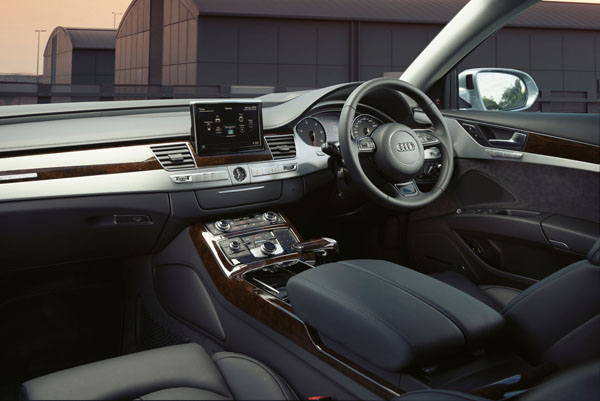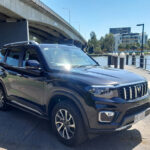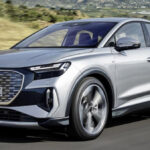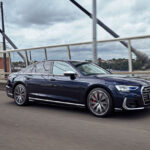The Audi flagship, the A8 sedan, has undergone a refit resulting in its now including an impressive arsenal of luxury and technological sales firepower.
Shining light of the Audi halo car is the innovative headlamp system which introduces Matrix LED technology in which the high-beam comprises 25 small, individual light-emitting diodes per unit that can be dimmed individually.
This enables the headlights to react to oncoming traffic or vehicles in front and blank out light with precision while continuing to fully illuminate the rest of the road.
Our test car, an A8 4.2 TDI quattro tiptronic tagged at $249,900, was graced with options including Dynamic Steering ($3550), Night Vision Assist ($5960) and Bang and Olufsen sound system ($14,500), pushing the price to $273,910, to which on-road costs have to be added.
STYLING
This is the largest sedan in the segment and it looks like it. Work has been done on the A8’s limo-like proportions with 130 mm being added to its length (now 5.14 metres) and wheelbase (2.99 metres), while the voluminous boot (502 litres, room for four golf bags), with automatic lid, has been revised to make access easier.
More shape has been added to the bonnet, single-frame grille and front bumper to give more expression to the exterior. The rear LED lighting has been revised also. Trapezoidal tailpipe tips on each side put finishing touches to the rear.
Inside, it’s wide open spaces, luxurious surroundings and an air of relaxation. Seats are clothed in quality leather and offer a number of comfort options including ventilation and massage. Leg room is extensive, especially in the rear, as befits a luxury limo.
Ambient lighting is a combination of LEDs, light guides, light strips and indirect illumination of the centre console. The driver can set the mood by choosing between colour schemes of Ivory, Polar, or Ruby/Polar and adjust brightness in four zones through the Multi-Media Interface control on the centre console.
INFOTAINMENT
Information and entertainment are controlled in two sections – MMI navigation plus with MMI touch – and displayed on an 8-inch retractable screen on the upper dashboard. The radio unit combines the functions of tuner and sound system, standard Bose surround sound. A high-end Bang and Olufsen concert-style set-up can be had for a hefty $14,500 premium.
The main unit contains additional components, including a DVD drive, two card readers and a 60 GB hard drive with the navigation data. A third of its capacity is reserved as memory for telephone and music data. The Audi music interface and Bluetooth interface make it easy to connect mobile devices and cell phones.
A pair of 10.2-inch displays are mounted on the backrests of the driver and front-passenger seats, which can each display different content. Rear seat entertainment includes its own DVD drive, a hard drive jukebox, two slots for SD memory cards and a separate Audi music interface for connecting mobile players.
It also offers full access to the sound system, TV tuner and MMI navigation plus and is controlled via a separate MMI panel in the rear centre armrest. Sound is supplied via the car’s speakers or two sets of either wired or Bluetooth headphones.
ENGINE / TRANSMISSION
Australian A8s are offered with the choice of two turbo-diesel engines, a 3.0-litre V6 and 4.2-litre V8. Both meet Euro 6 emission standards.
With the V8 of the test vehicle pumping out 283 kW and 850 Nm Audi claims a sprint to 100 km/h from rest in 4.7 seconds on the way to a governed 250 km/h, a surprisingly sporting performance for such a large car.
Audi tells us the official fuel consumption has been cut by up to 10 per cent over the previous engines. The maker claims combined fuel consumption of 7.4 litres per 100 kilometres for our test car. Yet we recorded 16-plus litres per 100 kilometres in the urban environment, and a much more respectable 6.6 litres per 100 at motorway speeds.
Engineers have managed to dramatically reduce engine speed of the V8 diesel to 800 rpm for improved fuel efficiency, while thee addition of AdBlu to the catalytic converter breaks down nitrogen oxides and earn the motor a Euro 6 emission rating.
The eight-speed tiptronic transmission enables the lower ratios to be close for sporty take-off, while upper ratios are wider for fuel efficiency. The Dynamic Shift Program controls the transmission in two automatic modes D and S.
The driver can operate the transmission electronically via the shift lever on the centre console or steering wheel-mounted paddles
The Audi quattro permanent all-wheel drive shuffles power between front and rear axles – normally 40 per cent front, 60 per cent rear – unless slipping occurs when power is automatically directed to the axle with least slip.
The 4.2 TDI also takes advantage of a standard sport differential for the rear axle which shifts power between the rear wheels, for example, in fast bends where the sedan is pushed into the inside.
Everything can be combined with the Drive Select system in which the driver can vary the function in five steps – auto, dynamic, comfort, individual and efficiency.
SAFETY
The body of the Audi A8 is designed to protect passengers in any type of collision, while an adaptive restraint system protects occupants of different sizes by collaboration between the airbags and the belt force limiters.
Audi Pre-Sense safety is available in a range of options, each looking out for unsafe driving conditions and mitigating their effects through sensors and the sedan’s electronic stabilisation control.
DRIVING
The A8 may rely on diesel power but it is no truck or tractor. Thanks to the attention paid to insulation, engine noise was almost totally absent from the cabin interior. Wind noise was likewise minimised by the use of acoustic glazing.
In keeping with the A8’s philosophy of luxury living, the Drive Select system was given short shrift by test car passengers, the ‘auto’ and ‘comfort’ settings appearing most appropriate for occupants enjoying the elegant lifestyle to which they had quickly become accustomed.
Driver assistance is literally front and centre in the new A8, for the first time offering a head-up display. Information appears to float in a window a couple of metres in front of the windscreen, enabling the driver to take in the images quickly because the eyes, focused on distance vision, only have to make a minimum of adjustment.
Preferred information for the head-up display can be selected via the MMI, the driver adjusting the height and brightness of the image. Other helpful systems include adaptive cruise control with stop&go function, side assist, lane assist and park assist.
SUMMING UP
Few people who spend some time in the new Audi A8 would deny their lifestyle had changed for the better. The unique quality of the experience is well worth the drive. Whether it is worth the fiscal outlay is purely up to the potential buyer, or more likely, his or her bank manager.
AT A GLANCE
A8 3.0 TDI quattro 3.0-litre diesel four-door sedan: $195,000 (automatic)
A8 4.2 TDI quattro 4.2-litre diesel four-door sedan: $249,900 (automatic)
A8 L (LWB) 3.0 TDI quattro 3.0-litre diesel four-door sedan: $206,900 (automatic)
Note: These prices do not include dealer or government charges. Contact your local Audi dealer for drive-away prices.
FEATURES (3.0 TDI)
19-inch alloy wheels in 10-spoke Y design
LED headlights including high-beam assist
Adaptive air suspension
Active lane, side assist and park assist systems
Adaptive cruise control with stop and go function including Audi pre sense plus
Power assisted door closure
BOSE surround sound system
Audi connect
DAB+ digital radio reception
Heated and ventilated front seats
Power assisted door closure
Electric opening and closing boot lid
Ambient interior lighting
20-inch alloy wheels in 10 parallel-spoke design (4.2 TDI)
Matrix beam LED headlights (4.2 TDI)
Head-up display (4.2 TDI)
Digital TV reception (4.2 TDI)
Massage function for front seats (4.2 TDI)
quattro sport differential (4.2 TDI)
SPECIFICATIONS (Audi A8 4.2 TDI diesel engine)
ENGINE
Capacity: 4.134 litres
Configuration: V8 with 90 deg V angle. Chain drive, roller cam followers with hydraulic valve play compensation. 4 valves per cylinder
Bore x Stroke: 83.0 mm x 95.5 mm
Compression Ratio: 16.5:1
Maximum Power: 283 kW @ 3750 rpm
Maximum Torque: 850 Nm @ 2000-2750 rpm
DRIVELINE:
quattro permanent all-wheel drive with self-locking centre differential,
electronic stabilisation control (ESC). Clutch, hydraulic torque converter with lock-up clutch. Transmission, 8-speed tiptronic with DSP and sport program
DIMENSIONS, WEIGHT AND CAPACITIES:
Length: 5135 mm
Width: 1949 mm
Height: 1460 mm (with roof rack)
Wheelbase: 2992 mm
Track: 1644.0 mm (front); 1635 mm (rear)
Tare weight: 2115 kg
Kerb weight: 2040 kg
Gross weight limit: 2705 kg
Drag co-efficient: Cd 0.27
Cargo capacity: 520 litres
Fuel Tank Capacity: 82 litres
Towing capacity: 2300 kg (braked) / 750 kg (unbraked)
Turning circle: 12.3 m
SUSPENSION AND BRAKES:
Suspension: Five-link suspension, upper and lower wishbones, tubular anti-roll bar, air suspension (front) / Trapezoidal-link suspension with wishbones, tubular anti-roll bar, air (rear)
Brakes: Dual-circuit system with diagonal split with ESC/ABS/EBD, brake
booster; hydraulic brake assist; front and rear disc brakes: ventilated;
electromechanical parking brake
Steering: Electromechanical with speed-dependent power assistance
Wheels / tyres: Aluminium alloy wheels 9.0Jx20 / 265/40 R20 104 Y XL
PERFORMANCE
Acceleration 0 to 100 km/h: 4.7 sec
Top speed: 250 km/h (governed)
FUEL CONSUMPTION:
Fuel type: Diesel
Combined Cycle (ADR 81/01): 7.4 litres per 100 km. CO2 emissions 194 grams / km
Emission rating: Euro 6
GREEN VEHICLE GUIDE RATINGS:
Greenhouse Rating: 6.5 / 10
Air Pollution Rating: 7.5 / 10
STANDARD WARRANTY:
Three years / unlimited kilometres














